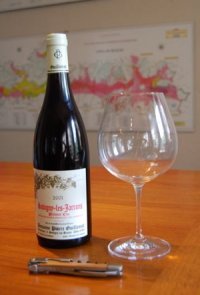|
Burgundy Wine Region
Yet, even with the simplicity of grape varieties, there is endless variety and resulting confusion in Burgundy wine. Burgundy wine bottle labels are often confusing for one. They don't say Pinot or Chardonnay anywhere on them. Most don't say Burgundy wine either. Also, the largest font type on the label is not the producer, but rather the appellation within the region that the wine comes from. Terroir, the nuances that each individual place gives to a wine, is much more important to the Burgundians than the grape. So you will see Chambertin on the label, not Pinot Noir, because the place (Chambertin is the name of a famous vineyard) is much more important in deciding how the wine will taste, its character and unique personality. The Region: Okay, so lets get to the basics. Burgundy (or Bourgogne in French) is the general name for a region that runs roughly north-south in the region a ways south-east of Paris, down to just above the start of the Northern Rhône Valley. It is separated into several smaller areas. In the far north is Chablis, an appellation producing mostly dry white wines from 100% Chardonnay. Further south, starting south of Dijon, is a strip of land known as the Côte d'Or, or slopes/hillsides of gold. This relatively small region is from where most of the most famous Burgundy wines originate. It is further subdivided into two regions, the northernmost being the Côte de Nuits and the southernmost being the Côte de Beaune. Each are further subdivided into several small villages surrounded by vineyards. In the Côte d'Or red wines are almost exclusively made from 100% Pinot Noir (with the exception of Bourgogne passetoutgrains which incorporates Gamay) and the whites are mostly 100% Chardonnay, although there are a few notable exceptions which include Pinot Blanc and other related white varietals like Pinot Gouges (a white mutant of Pinot Noir). The large majority of wines made in the northern Côte de Nuits are red, most of the famous white Burgundies coming from the southern Côte de Beaune. A good deal of red wine is also produced in the Côte de Beaune from such villages as Volnay, Pommard, Aloxe-Corton and others. South of the Côte d'Or is a vast area including the Cote Chalonnaise and Macônnaise which make a lot of wine, most of which is not as famous or as profound as the wines from further north. There are notable exceptions as there are several producers that make outstanding wines from this region. One of the notable regions in the far south of Burgundy is Beaujolais which produces wines exclusively from the Gamay grape. While it is most known worldwide for its fresh, fruity and simple wines such as Beaujolais Nouveau and most Beaujolais-Villages, it is capable of making more serious, complex wines from the great crus of Beaujolais such as Morgon, Moulin-a-Vent, Fleurie and others. Burgundy Wine Grape Varieties: Sub-Appelations within Burgundy: Burgundy is further subdivided into many villages. These villages are surrounded by vineyards where the grapes come from. Some wines are simply "village" wines, meaning that the grapes were grown somewhere within that village appellation. Within each village, individual vineyards (the actual vineyard, not the producer), are graded. Premier cru vineyards are ones with special distinction above the basic village vineyards. The very best vineyards producing Burgundy wine, which have the best terroir and are considered to consistently produce the best wines, are called Grand Cru. Premier cru wines have both the village and vineyard name on the label generally. There are some exceptions which are simply premier cru from a village which means it is probably a blend of grapes from various premier cru vineyards within that village. The Grand Cru wines have just the vineyard name on the label as the vineyard itself is the appellation. Wines labeled as such, with only one vineyard name on the label, can only have been produced from vines in that specific vineyard. Wine Names - Deciphering Labels: Most wines are named for the appellation and/or vineyard the grapes come from and this is the most prominent text on the label. For example, village wines are named simply for the name of the village the grapes were grown in. Examples of famous villages include Gevrey-Chambertin, Chambolle-Musigny, Vosne-Romanée, Volnay, Puligny-Montrachet, Meursault, etc. Occasionally, if all the grapes come from a named vineyard that is not a premier or grand cru, you will see a vineyard name below the village. These are called lieu dits. However, below the name, the AOC will clearly identify it as a village wine by saying Appellation (Village name here) Contrôlée, such as Appellation Gevrey-Chambertin Contrôlée. Premier cru Burgundy wine is labeled with both the village name followed by the name of the specific premier cru vineyard. These can be identified because the appellation is listed as premier cru, such as Appellation Gevrey-Chambertin Premier Cru Contrôlée. Grand cru wines are labeled only with the name of the grand cru vineyard, not the village name. For example, Chambertin is one of the most famous grand cru vineyards and resides in the village of Gevrey-Chambertin. The largest text on the center of the label will say Chambertin with Appellation Chambertin Contrôlée below it. The grapes for this wine came exclusively from the Chambertin vineyard within the village of Gevrey-Chambertin. Lastly, there is producer. The producer is the actual wine maker or domaine that made the wine. Some producers both grow the grapes and vinify the wine. However, some buy grapes or fermented grape juice from growers and then finish making and bottling the wine themselves (these are called negociants). Some very large producers do both, some wines they own the vines and grow the grapes, others they buy from other growers. The producer name is most commonly listed on the lower left of the label, although there is some variety to this. Important Note!Unlike many wine regions where each vineyard has a single owner and producer, Burgundy sine is much more complicated. Most vineyards have several or even dozens of owners who own small plots of vines within that vineyard. Any one given producer may own small plots in many different vineyards. This means that any given producer may produce several different wines each year, from different vineyards and appellations. Conversely, in any one vintage, most vineyards can be produced (from different plots) by many different producers. The reason this is important is that buying a good wine requires more than just looking for the best vineyard. For example, a large grand cru vineyard like Clos de Vougeot may have dozens of examples made each year from different producers. If you just go out and buy any old Clos de Vougeot, it will be very hit or miss! Some producers may be excellent and make wonderful wine from Clos de Vougeot while mediocre or poor producers may make a pitiful Clos de Vougeot. In other words, it is important to consider both the vineyard or appellation as well as the producer when learning about and buying Burgundy wine. What Do The Wine's Taste Like? In general, the red wines of Burgundy are less full-bodied than Bordeaux. They do not have as dark a color and generally do not have as firm a tannic structure. Instead, they are lighter in color and their structure is often built more on acidity, making them seem a bit lighter in body and more zesty or tangy on the finish, at least in their youth. As the wines age, they are capable of developing a huge bouquet of aromas from flowers and fruits to minerals, earth, mushrooms and truffles. A well aged Burgundy can be so aromatic you literally don't want to take a sip, you could just sniff it all night long. The textures can be caressing and elegant or firm and gripping in their youth. As you can probably see, trying to describe the wines is a difficult task. Each village and vineyard has its own unique character and while one Burgundy may be pretty, flowery, soft and feminine, another may be meaty, earthy and masculine. The white wines of Burgundy vary quite a bit as well. The Chardonnay can give anywhere from light to full-bodied wines. Generally, the wines have a depth of fruit but it is well balanced by stones and minerals and a crisp acidity that gives it grip and firmness. Both the best red and white Burgundies can require extended aging to really show their best and many are capable of many decades of evolution. Return to the French Wine Regions section.  |



 The Burgundy wine region is at once one of the most famous, the most simple and yet the most misunderstood, difficult to understand and frustrating. On the surface, it is simple, most of the famous red wines from Burgundy are made from 100% Pinot Noir. Most of the famous white wines from Burgundy are made from 100% Chardonnay. What could be more simple? What could be more uniform?
The Burgundy wine region is at once one of the most famous, the most simple and yet the most misunderstood, difficult to understand and frustrating. On the surface, it is simple, most of the famous red wines from Burgundy are made from 100% Pinot Noir. Most of the famous white wines from Burgundy are made from 100% Chardonnay. What could be more simple? What could be more uniform?


